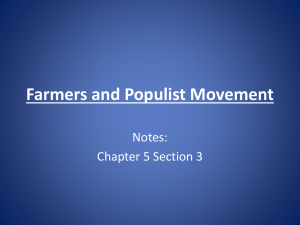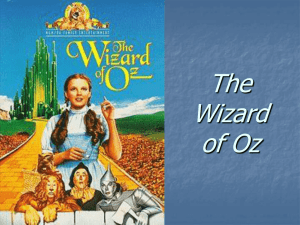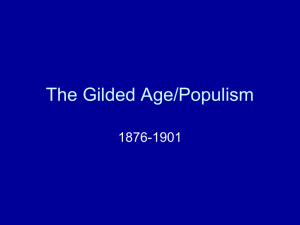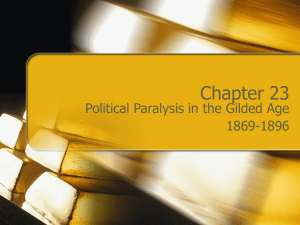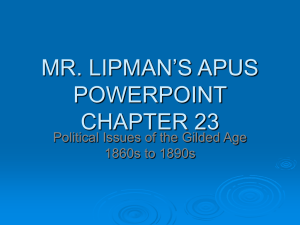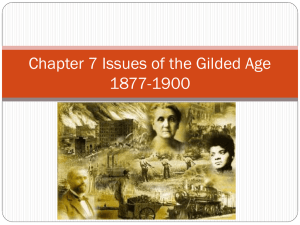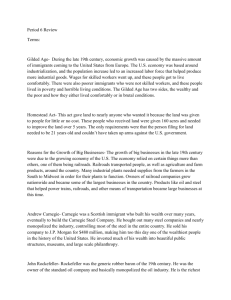"THE GILDED AGE" - Late 19th century
advertisement
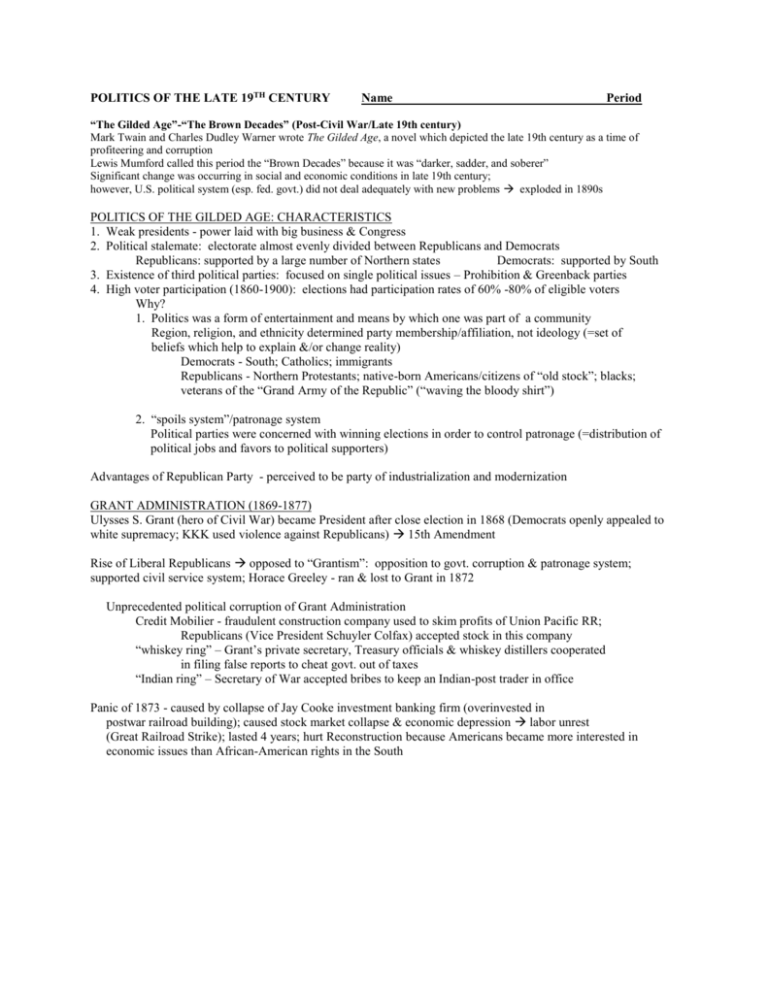
POLITICS OF THE LATE 19TH CENTURY Name__________________________________Period “The Gilded Age”-“The Brown Decades” (Post-Civil War/Late 19th century) Mark Twain and Charles Dudley Warner wrote The Gilded Age, a novel which depicted the late 19th century as a time of profiteering and corruption Lewis Mumford called this period the “Brown Decades” because it was “darker, sadder, and soberer” Significant change was occurring in social and economic conditions in late 19th century; however, U.S. political system (esp. fed. govt.) did not deal adequately with new problems exploded in 1890s POLITICS OF THE GILDED AGE: CHARACTERISTICS 1. Weak presidents - power laid with big business & Congress 2. Political stalemate: electorate almost evenly divided between Republicans and Democrats Republicans: supported by a large number of Northern states Democrats: supported by South 3. Existence of third political parties: focused on single political issues – Prohibition & Greenback parties 4. High voter participation (1860-1900): elections had participation rates of 60% -80% of eligible voters Why? 1. Politics was a form of entertainment and means by which one was part of a community Region, religion, and ethnicity determined party membership/affiliation, not ideology (=set of beliefs which help to explain &/or change reality) Democrats - South; Catholics; immigrants Republicans - Northern Protestants; native-born Americans/citizens of “old stock”; blacks; veterans of the “Grand Army of the Republic” (“waving the bloody shirt”) 2. “spoils system”/patronage system Political parties were concerned with winning elections in order to control patronage (=distribution of political jobs and favors to political supporters) Advantages of Republican Party - perceived to be party of industrialization and modernization GRANT ADMINISTRATION (1869-1877) Ulysses S. Grant (hero of Civil War) became President after close election in 1868 (Democrats openly appealed to white supremacy; KKK used violence against Republicans) 15th Amendment Rise of Liberal Republicans opposed to “Grantism”: opposition to govt. corruption & patronage system; supported civil service system; Horace Greeley - ran & lost to Grant in 1872 Unprecedented political corruption of Grant Administration Credit Mobilier - fraudulent construction company used to skim profits of Union Pacific RR; Republicans (Vice President Schuyler Colfax) accepted stock in this company “whiskey ring” – Grant’s private secretary, Treasury officials & whiskey distillers cooperated in filing false reports to cheat govt. out of taxes “Indian ring” – Secretary of War accepted bribes to keep an Indian-post trader in office Panic of 1873 - caused by collapse of Jay Cooke investment banking firm (overinvested in postwar railroad building); caused stock market collapse & economic depression labor unrest (Great Railroad Strike); lasted 4 years; hurt Reconstruction because Americans became more interested in economic issues than African-American rights in the South Rise of Greenback issue Panic of 1873 & subsequent depression led debtors to pressure fed. govt. to inflate national currency ; wanted fed. govt. to issue more “greenbacks” (=Epaper currency issued during Civil War): greenbacks would increase amount of money in circulation lower value of dollar reduce value of debt Grant & other Republicans favored “sound” currency (based on gold reserves) which kept value of dollar high debt (owed creditors) high Grant vetoed bill to expand greenbacks (1874 ) Republicans in Congress passed Specie Resumption Act (1875): after Jan. 1, 1879, greenback dollars would be redeemed by fed. govt. and replaced with new gold-backed dollars firmly tied to price of gold/gold-backed certificates; supported by creditors & angered debtors (limited expansion of money supply) Greenback Party (1875 & next 3 national elections) Silver movement of 1890s Divisions within Republican Party, the 1880 Election, & the Garfield-Arthur Presidency (1881-1885) Compromise of 1877 Presidency of Rutherford B. Hayes (1877-1881): “His Fraudulency” Constant conflict between Republican factions: Stalwarts v. Half-Breeds Most important difference - control over political patronage Mugwumps - Liberal/Reform Republicans; opposed patronage system Bland-Allison Act (1878) - fed. govt. began limited expansion of silver-backed currency 1880 ELECTION: Republicans nominated James A. Garfield for President (Half-Breed) and Chester Arthur for Vice-President (Stalwart) vs. Winfield Hancock (Democrat) Republicans won July 1881 - Garfield shot by rejected office-seeker (Charles Guiteau); died 3 months later Arthur became President; turned against Stalwart organization & supported Pendleton Act (1883) – first national civil service system (=government jobs were to be given on basis of competitive written examinations) Initially, less than 15% of federal jobs were covered by Pendleton Act gave President authority to increase number of civil-service positions by executive order (=presidential decree that needs no congressional approval) 1884 Election: Republican - James Blaine vs. Grover Cleveland - Democrat: “veto governor” No major difference on important issues election focused on personal scandal Blaine hurt due to perceived tolerance of slander on Catholics (“Rum, Romanism, & Rebellion”) New York (large number of Catholic voters) supported Cleveland Cleveland - 219 electoral votes; Blaine - 182 electoral votes; New York - 36 electoral votes Presidency of Grover Cleveland (1885-1889) Main concern was reduction of size and role of government “Though the people support the Government, the Government should not support the people” Cleveland tried to reduce tariff; blocked by Republicans issue in 1888 election Public criticism of railroad power led to passage of state laws that regulated railroads Supreme Court (in Wabash case) ruled state regulation of interstate commerce was unconstitutional (bec. it was sole power of fed. govt.) passage of Interstate Commerce Act (1887): provided for restrictions on unpopular & unethical railroad actions and created Interstate Commerce Commission (ICC) to administer Reality: law had little practical effect due to limited federal govt. enforcement & lack of judicial support. 1888 Election Cleveland v. Benjamin Harrison Harrison won (despite Cleveland winning plurality of popular vote) Presidency of Benjamin Harrison (1889-1893) Harrison increased tariff (McKinley Act) and signed into law Sherman Antitrust Act (July 1890): “any contract, combination in the form of trust or otherwise, or conspiracy in restraint of trade or commerce” is illegal. Why was law passed? Public criticism of “trusts” (term referred to any large business that dominated its field) little impact because limited enforcement of law Weakened by E.C. Knight case (1895) - fed. govt. only allowed to regulate interstate commerce, not manufacturers Sherman Antitrust Act was used against labor unions: unions were a "labor trust" Sherman Silver Purchase Act (1890) - required fed. govt. to increase purchases of silver, & issue Treasury notes redeemable in gold and silver; believed by Cleveland to have caused 1873 Panic “Billion Dollar” Congress – Congress passed the first billion-dollar federal budget (1892) Tariff increase hurt Republicans in 1890 elections; lost control of Congress to Democrats 1892 Election – Rematch: Cleveland vs. Harrison; Cleveland won Rising anger against social & economic conditions Populist Party won 8.5% of popular vote (1 million votes) Second Presidency of Grover Cleveland (1893-1897) Cleveland was able to get slight reduction in tariff (Wilson-Gorman Tariff). It also contained an income tax (later ruled unconstitutional); However, he was unwilling to use powers of federal government to alleviate economic depression caused by Panic of 1893 (see “The Populist Movement. . .” notes) Repeal of Sherman Silver Purchase Act (1893) - eliminated fed. govt. purchases of silver Pullman Strike (see “Rise of American Labor Unions” notes) - Cleveland's alliance with Pullman Company angered many Democrats State & Local Governments’ Attempts to solve Problems State and local govts. passed laws that attempted to regulate railroads, reduce political corruption, eliminate urban blight, and legislate social behavior (store-closing on Sundays, prohibition of alcohol sales, making English the only public school language) Supreme Court limited state regulation of railroads (see “The Populist Movement . . .” notes) ----------------------------------------------------------------------------------------------------------------------------- ---ATTENTION: THE MATERIAL THAT FOLLOWS IS EPISODE 17 MATERIAL. START THE POPULISM SLIDES AT THIS POINT. ----------------------------------------------------------------------------------------------------------------------------- --------------- THE POPULIST MOVEMENT AND THE CRISIS OF THE 1890s “We meet in the midst of a nation brought to the verge of moral, political, and material ruin . . . labor impoverished . . . the fruits of the toil of millions are boldly stolen to build up colossal fortunes for a few. . . . From the prolific womb of injustice we breed the two great classes -- tramps & millionaires.” - Populist Party Platform, 1892 Populism was a political movement which developed as reaction to economic difficulties of farmers Populist – appeals to the “common man”/“common person”; use of vernacular language/language of “the people”; critical of “elites” Problems of farmers (see “Settlement & Conquest of Trans-Mississippi West: Post-1860”) 1. Decline in commodity prices (=prices on farm goods) 2. International competition 3. Railroads & “middlemen” 4. High tariffs 5. Debt 6. Inadequate currency 7. Problems of geography, climate, and water 8. Lack of community Origins of the Populists 1. Grangers/The Grange (National Grange of the Patrons of Husbandry) A. founded by Oliver H. Kelley (1867) B. purposes 1. provide new scientific agricultural techniques (keep farming "in step with the ages") 2. develop feeling of community among farmers (like urban fraternal organizations) C. Growth in Grange membership 1. Depression of 1873 caused decline in farm prices 2. 1875 - 800,000 members D. Economic activities 1. formed cooperatives - avoid “middleman”: stores, creameries, elevators, warehouses, insurance companies 2. Montgomery Ward and Company (1872) - first mail order company E. became more political 1. “The Farmers’ Declaration of Independence” - Independence Day (1873) 2. elected supportive state legislators of “Antimonopoly” and “Reform” passed Granger laws a. restricted railroad power b. Court decisions limited Granger laws: 1. Munn v. Illinois (1877) - states allowed to regulate private property that serves common good 2. Wabash v. Illinois (1886) - states cannot regulate interstate commerce F. Decline of the Grange 1880 - 100,000 members Why? a. Return of prosperity b. negative judicial court decisions c. political inexperience 2. Farmers’ Alliances A. Successor to the Granges B. Southern Alliance - Dr. Charles Macune, Colored Alliance (South); Northwestern Alliance (Midwest) C. Achievements 1. Formation of stores, cooperatives, processing plants, etc. that attempted to free farmers from “middlemen” 2. emphasized cooperation 3. Women played important role 4. provided community D. Problems 1. Cooperatives limited success: market forces, mismanagement, & unscrupulous local businessmen failures 2. Numerical strength & strong beliefs & economic failures pushed Alliances toward political action. E. Political Action 1. Ocala, Florida national convention (1890) a. staged by the various alliances b. issued the Ocala Demands 2. Political success a. 1890 elections: candidates supported by Alliances won partial or complete control of 12 state legislatures; elected 6 governors, 3 senators, about 50 congressmen b. encouraged formation of political party 3. Creation of the Populist Party A. July 1892 (Omaha, Nebraska) – creation of the People’s Party B. Populist Party platform (see handout) 1. Finance & aid to farmers subtreasury system govt. control of money supply (not private bankers) income tax “free silver” 2. Transportation: govt. own railroads (in the interests of the people) 3. Land: land owned by railroads, “aliens”, and speculators reclaimed 4. Political reforms direct election of senators initiative and referendum secret ballot single four-year presidential term 5. Attempt to build alliance with urban workers shorter work week for laborers limitation on immigration ultimately unsuccessful different interests C. 1892 election - Populist candidate - James Weaver: 1 million votes - 8.5% 1,500 Populist candidates elected in state legislatures; 3 governors, 5 senators, 10 congressmen D. Populist constituency/supporters: poorest, isolated & unable to adapt to economic changes greatest influence: states extending from Dakotas southward through Nebraska & Kansas; string of Southern states stretching from Texas through northern Louisiana, Alabama, and Mississippi, and into Georgia and Carolinas; and Rocky Mountains states E. Prominent leaders & personalities 1. Mary E. Lease – “raise less corn and raise more hell” 2. Tom Watson - Georgia: biracial coalition F. South - beginnings of development of political alliance between black and white farmers; Fear of this alliance aided in development of Jim Crow laws; some Populist leaders ended up as race-baiting demagogues (Tom Watson) Panic of 1893 Depression of 1890s Worst depression in American history (up to that time) Why? IMMEDIATE CAUSE - collapse of two major corporations (Philadelphia & Reading Railroad and National Cordage Company) caused collapse of stock market Collapse of stock market led to bank failures because many banks invested in the stock market Bank failures decrease of credit (bank loans) collapse of businesses LONG-RANGE CAUSES 1. Depressed agricultural prices led to decreased purchasing power of farmers (still largest population group) 2. Depression in Europe led to loss of American markets abroad 3. Businesses expanded too rapidly; could not support investments in an economic decline i.e. railroads 4. Interdependence of the American economy: economic collapse in one area affected other areas, esp. railroads Economic collapse (20% unemployment) political and labor unrest 1. Coxey’s Army (1894) - Jacob Coxey led thousands marched to Washington D.C. to support public works projects in order to give unemployed work; barred form the capital 2. Labor unrest – Pullman strike Political result: Republicans regained control of Congress in 1894 elections Silver as a Political Issue 1. Issue: What would give the dollar its value?: Gold & silver (=gold standard) OR more silver & gold (=free silver) Today: Value of the dollar – declaration by government that it has value & citizens’ belief in that value (fiat money) 2. Silver supporters: farmers Why? Increase in silver increase in the money supply inflation increase in farm prices Debtors (farmers) like inflation because debts are repaid with money worth less than when original loan was made 3. Creditors (like banks) dislike inflation for same reason gold 4. Changing monetary policy by the federal government and growing support for silver “bimetallism” - use of two metals (gold and silver) as specie to back up U.S. money (up to 1873) “Crime of ‘73” - fed. govt. stopped coining silver because price of silver was high and used for manufacturing; became controversial when price of silver dropped Specie Resumption Act (1875): after Jan. 1, 1879, greenback dollars would be redeemed by fed. govt. & replaced with new gold-backed dollars firmly tied to price of gold/gold-backed certificates; supported by creditors & angered debtors (wanted expanded money supply) Greenback Party (1875-1880s) Bland-Allison Act (1878) - fed. govt. began limited expansion of silver-backed currency Sherman Silver Purchase Act (1890) - required fed. govt. to increase purchases of silver, & issue Treasury notes redeemable in gold and silver; believed by Cleveland to have caused 1893 Panic Repeal of Sherman Silver Purchase Act (1893) - eliminated federal government purchases of silver Coin’s Financial School (1895) - William H. Harvey's advocacy for coinage of silver 5. Populists did not see silver as most important issue (like restrict power of railroads & other “trusts”); became more important due to need for financial support (from silver mine owners) and expanding their political alliance Election of 1896 (also called “Battle of the Standards” because of the debate over silver) 1. Republicans selected William McKinley; aided by Mark Hanna (boss of Ohio political machine and soon-to-be national boss of Republican Party) Platform - opposed free coinage of silver 2. Democrats - dramatic convention South & West delegates: supported free silver, tariff reduction, income tax, stricter control over trusts and railroads, opposed use of injunctions in industrial disputes vs. Eastern delegates: opposed “free silver” William Jennings Bryan’s “Cross of Gold” speech: “Having behind us the producing masses of this nation and the world, supported by the commercial interests, the laboring interests and the toilers everywhere, we will answer their demand for a gold standard by saying to them: “You shall not press down upon the brow of labor this crown of thorns; you shall not crucify mankind upon a cross of gold.” Bryan won nomination 3. Populist Party realized Democrats had co-opted/stolen much of their political program nominated Bryan as President & selected Populist Tom Watson as V.P.; Democrats ignored 4. 1896 election campaign has been described as first “modern” campaign A. Republicans received $7 million in campaign contributions from businesses because they feared Bryan (who was called a “Popocrat”); McKinley – “front-porch” campaign Some businesses threatened their workers with job loss if they voted for Bryan; some banks said they would not renew mortgages of farmers if Bryan won (result of no secret ballot) B. Democrats - only had $300,000 to spend on the campaign Bryan - one of the first presidential candidates to travel throughout the country and campaign himself (subsequent presidential candidates would continue to do this) C. Result: McKinley 51% 271 electoral votes; Bryan 48% 176 electoral votes D. Why did Bryan lose? 1. agricultural program appealed to poorest farmers not enough votes 2. increase in wheat prices before election led to decrease in Western farmer discontent 3. unable to attract urban workers 4. Pressure from big business 5. Democrats blamed for 1890s depression (since they controlled Presidency when it began) E. Importance of 1896 Election 1. It made Republican Party the majority party until the 1930s Supporters: Northeast, Midwest, urban America, big and small business, some farmers (especially successful) 2. Demise of the Populist Party: By 1897, Populist Party began to dissolve 1898 to 1914: 1 million Americans (mostly Populist farmers) moved to Canada; formed foundation of left-wing Canadian political parties “For a hundred years [1790s to 1890s] . . . the American people had hesitated, vacillated, swayed forward and back, between two forces, one simply industrial [productive], the other capitalistic, centralizing and mechanical. . . . the majority at last declared itself, once and for all, in favor of the capitalistic system with all its necessary machinery. All one’s friends, all one’s best citizens, reformers, churches, colleges, educated classes, had joined the banks to force submission to capitalism.” Henry Adams F. Why did the Populist Party disintegrate? 1. Gradual easing of the economic crisis for much of the country How? a. Foreign crop failures led to increased demand for American crops b. Period of economic growth c. Discovery of new gold deposits (Alaska) expanded money supply 2. More focus on foreign policy: Spanish-American War (1898) U.S. as a world power Populism “was the beginning of a movement that in another decade was to change the politics of a nation” William Allen White, Kansas newspaper editor
